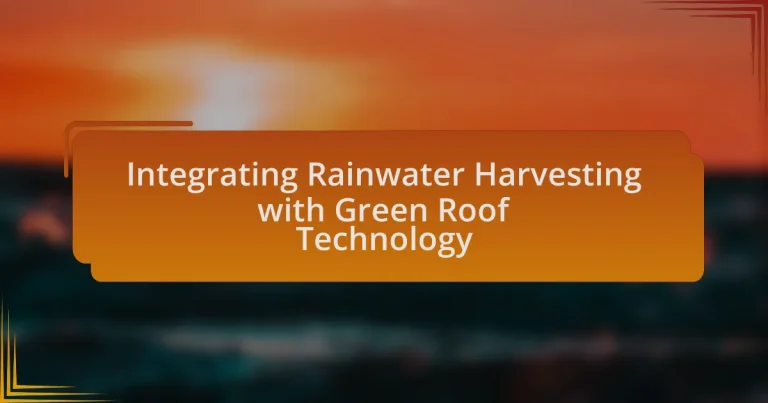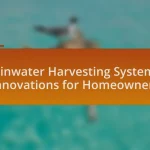Integrating rainwater harvesting with green roof technology combines systems that collect and utilize rainwater while promoting vegetation on rooftops. This integration enhances urban sustainability by managing stormwater, reducing runoff, and improving water quality, with green roofs capable of retaining up to 80% of rainfall. Key components include catchment areas, storage tanks, and drainage systems, while challenges such as structural limitations and maintenance complexities must be addressed. The article also explores practical applications in residential and commercial settings, the role of local governments in promoting these technologies, and future trends influenced by climate change and technological advancements.
What is Integrating Rainwater Harvesting with Green Roof Technology?
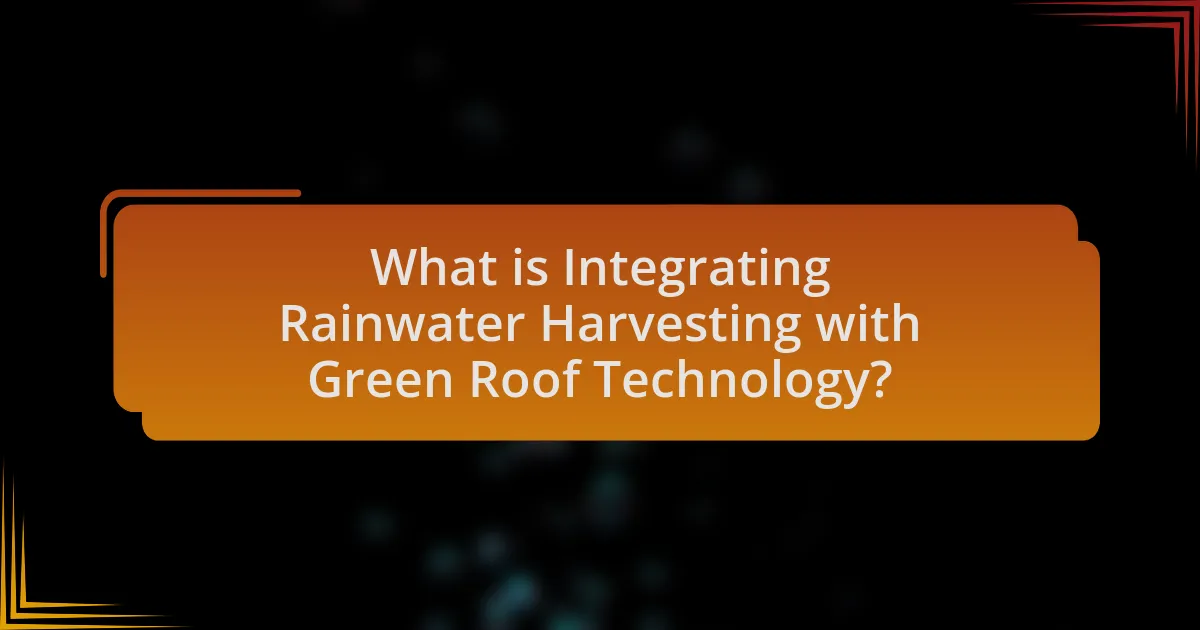
Integrating rainwater harvesting with green roof technology involves the combination of systems that collect and utilize rainwater while promoting vegetation on rooftops. This integration allows for the efficient management of stormwater, reduces urban heat, and enhances biodiversity. Studies indicate that green roofs can retain up to 80% of rainfall, while rainwater harvesting systems can store and reuse this water for irrigation and other non-potable uses, thereby decreasing reliance on municipal water supplies.
How does the integration of these two systems function?
The integration of rainwater harvesting and green roof technology functions by utilizing the green roof as a catchment area for rainwater, which is then collected and stored for various uses. This system enhances the efficiency of both technologies by allowing the green roof to absorb rainwater, reducing runoff and promoting plant health, while simultaneously providing a sustainable water source for irrigation and other applications. Studies have shown that this integration can significantly decrease stormwater runoff by up to 65%, demonstrating its effectiveness in urban environments.
What are the key components of rainwater harvesting systems?
The key components of rainwater harvesting systems include catchment areas, storage tanks, conveyance systems, and filtration systems. Catchment areas, typically roofs, collect rainwater, which is then directed through conveyance systems like gutters and downspouts to storage tanks. Storage tanks hold the collected water for later use, while filtration systems ensure the water is clean and safe for consumption or irrigation. These components work together to efficiently capture and utilize rainwater, promoting sustainable water management practices.
What elements constitute a green roof system?
A green roof system consists of several key elements: a waterproof membrane, a drainage layer, a growing medium, vegetation, and an optional irrigation system. The waterproof membrane prevents water from penetrating the building, while the drainage layer facilitates excess water flow and prevents root saturation. The growing medium supports plant growth and retains moisture, and the vegetation provides ecological benefits, such as improved air quality and insulation. An irrigation system may be included to ensure adequate water supply, especially in dry conditions. These components work together to create a sustainable and functional green roof.
Why is the integration of rainwater harvesting and green roofs important?
The integration of rainwater harvesting and green roofs is important because it enhances urban sustainability by managing stormwater, reducing runoff, and improving water quality. Rainwater harvesting captures and stores rainwater, which can be utilized for irrigation and other non-potable uses, thereby decreasing the demand on municipal water supplies. Green roofs, which are vegetated rooftops, absorb rainwater, reducing the volume and speed of runoff while providing insulation and habitat for wildlife. Studies show that green roofs can retain up to 80% of rainfall, significantly mitigating urban flooding and decreasing the burden on drainage systems. This combination not only promotes efficient water use but also contributes to urban biodiversity and climate resilience.
What environmental benefits arise from this integration?
Integrating rainwater harvesting with green roof technology provides significant environmental benefits, including improved stormwater management and enhanced biodiversity. This integration allows for the capture and utilization of rainwater, reducing runoff and minimizing the risk of flooding. Additionally, green roofs support various plant species, which contribute to urban biodiversity and provide habitats for pollinators. Studies have shown that green roofs can reduce urban heat island effects by lowering surface temperatures, thus improving air quality and reducing energy consumption for cooling.
How does this integration contribute to urban sustainability?
Integrating rainwater harvesting with green roof technology significantly contributes to urban sustainability by enhancing water management and reducing urban heat. This integration allows for the collection and utilization of rainwater, which decreases reliance on municipal water supplies and mitigates stormwater runoff, thereby reducing flooding and water pollution. Studies show that green roofs can lower ambient temperatures by up to 5°C, which helps combat the urban heat island effect. Additionally, the use of harvested rainwater for irrigation on green roofs promotes plant health and biodiversity, further supporting urban ecosystems.
What challenges are associated with integrating these technologies?
Integrating rainwater harvesting with green roof technology presents several challenges, including structural limitations, maintenance complexities, and regulatory hurdles. Structural limitations arise from the need for roofs to support additional weight from water storage systems and vegetation, which may require reinforcement. Maintenance complexities include the need for regular upkeep of both the green roof and the rainwater harvesting system to ensure functionality and prevent issues such as clogging or leaks. Regulatory hurdles often involve navigating building codes and zoning laws that may not accommodate these integrated systems, potentially delaying implementation.
What technical difficulties might arise during installation?
Technical difficulties that might arise during the installation of rainwater harvesting systems integrated with green roof technology include structural load limitations, improper waterproofing, and challenges in system connectivity. Structural load limitations can occur if the existing building cannot support the additional weight of the green roof and water storage components, potentially leading to safety hazards. Improper waterproofing may result in leaks, which can damage both the green roof and the underlying building structure, necessitating costly repairs. Additionally, challenges in system connectivity can arise when integrating plumbing and drainage systems, leading to inefficiencies in water collection and distribution. These issues highlight the importance of thorough planning and engineering assessments prior to installation.
How can maintenance issues impact the effectiveness of the systems?
Maintenance issues can significantly reduce the effectiveness of systems integrating rainwater harvesting with green roof technology. When maintenance is neglected, components such as gutters, downspouts, and storage tanks can become clogged or damaged, leading to inefficient water collection and storage. For instance, a study by the University of Toronto found that regular maintenance of green roofs can improve their water retention capacity by up to 30%. Additionally, the health of the vegetation on green roofs is directly linked to maintenance practices; poorly maintained plants can lead to reduced evapotranspiration, which diminishes the roof’s cooling effect and overall performance. Therefore, consistent maintenance is crucial for optimizing the functionality and benefits of these integrated systems.
What are the practical applications of Integrating Rainwater Harvesting with Green Roof Technology?
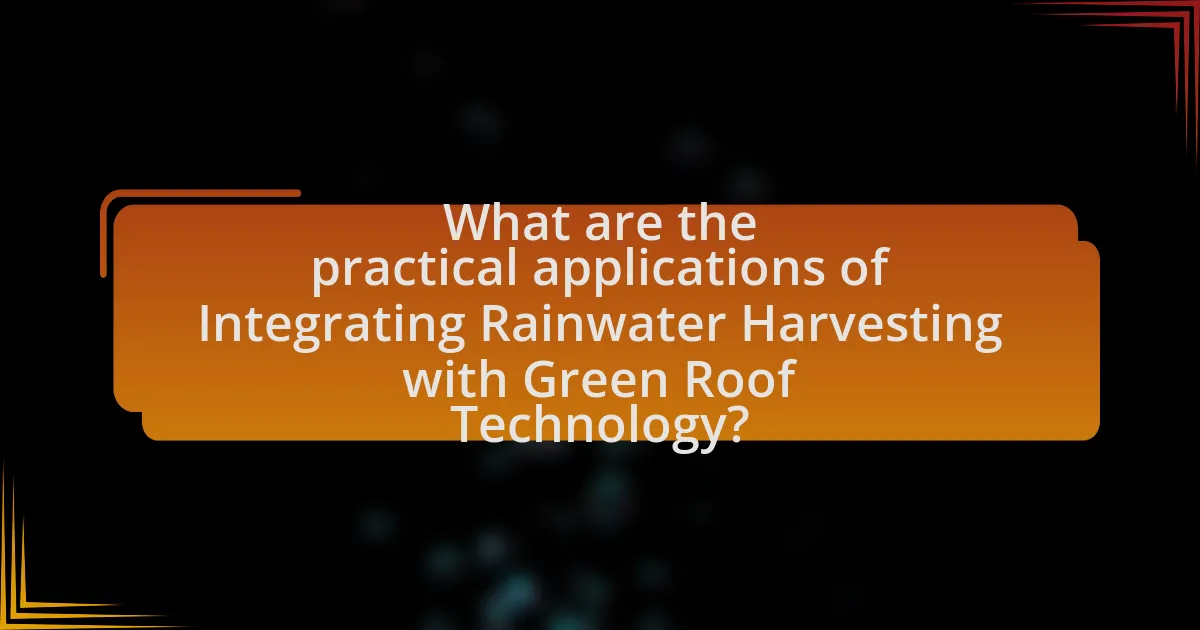
Integrating rainwater harvesting with green roof technology has practical applications in urban water management, stormwater mitigation, and enhancing biodiversity. This integration allows for the collection and storage of rainwater, which can be used for irrigation of the green roof, reducing the need for potable water. Additionally, it helps manage stormwater runoff by absorbing excess rainwater, thereby decreasing the risk of flooding and erosion in urban areas. Studies have shown that green roofs can reduce surface runoff by up to 65%, significantly alleviating pressure on drainage systems. Furthermore, this combination promotes biodiversity by creating habitats for various plant and animal species, contributing to urban ecological health.
How can this integration be implemented in residential settings?
Integrating rainwater harvesting with green roof technology in residential settings can be implemented by installing a rainwater collection system that channels water from the roof into storage tanks, while simultaneously utilizing a green roof to absorb and filter rainwater. This dual approach enhances water efficiency and promotes sustainable landscaping. Research indicates that green roofs can reduce stormwater runoff by up to 65%, making them effective in managing rainwater. Additionally, the stored rainwater can be used for irrigation, reducing reliance on municipal water sources and promoting environmental sustainability.
What design considerations should be taken into account for homes?
Design considerations for homes integrating rainwater harvesting with green roof technology include structural support, waterproofing, and plant selection. Structural support is essential to bear the additional weight of the green roof and water storage systems, ensuring the building can safely accommodate these features. Waterproofing is critical to prevent leaks and water damage, requiring high-quality materials and installation techniques. Plant selection must consider local climate, maintenance requirements, and biodiversity to ensure the green roof thrives and effectively contributes to rainwater management. These considerations are validated by studies showing that proper structural and environmental planning enhances the longevity and functionality of green roofs while optimizing rainwater harvesting efficiency.
What are the cost implications for homeowners?
The cost implications for homeowners integrating rainwater harvesting with green roof technology include initial installation expenses and potential long-term savings on water bills. Homeowners may face upfront costs ranging from $10,000 to $30,000 for the combined systems, depending on the size and complexity of the installation. However, these systems can reduce water usage by up to 50%, leading to significant savings over time. Additionally, green roofs can enhance property value by approximately 15% and provide benefits such as improved insulation and reduced stormwater management costs, further offsetting the initial investment.
What role does this integration play in commercial buildings?
The integration of rainwater harvesting with green roof technology plays a crucial role in enhancing sustainability in commercial buildings. This combination allows for the efficient collection and utilization of rainwater, which can be used for irrigation, reducing the demand on municipal water supplies. Additionally, green roofs provide insulation, which can lower energy costs, while also managing stormwater runoff effectively. Studies indicate that buildings with green roofs can reduce stormwater runoff by up to 65%, demonstrating the effectiveness of this integration in mitigating urban flooding and improving water management.
How can businesses benefit from adopting these technologies?
Businesses can benefit from adopting rainwater harvesting integrated with green roof technology by reducing water costs and enhancing sustainability. This integration allows businesses to collect and utilize rainwater for irrigation and other non-potable uses, significantly lowering their reliance on municipal water supplies. According to a study by the University of Toronto, green roofs can reduce stormwater runoff by up to 65%, which not only mitigates flooding but also decreases the costs associated with stormwater management. Additionally, the presence of green roofs can improve energy efficiency by providing insulation, leading to lower heating and cooling costs. Furthermore, businesses adopting these technologies can enhance their corporate image by demonstrating a commitment to environmental stewardship, which can attract eco-conscious consumers and investors.
What are some successful case studies of commercial integration?
Successful case studies of commercial integration include the implementation of rainwater harvesting systems in conjunction with green roof technology at various commercial properties. One notable example is the Chicago City Hall green roof project, which integrates a rainwater harvesting system that captures and utilizes stormwater for irrigation, reducing the building’s reliance on municipal water. This project has demonstrated a 50% reduction in water usage for landscape irrigation, showcasing the effectiveness of combining these two technologies. Another example is the Bullitt Center in Seattle, which features a green roof and a rainwater harvesting system that meets 100% of the building’s water needs for irrigation and toilet flushing, highlighting the potential for sustainable urban development. These case studies illustrate the successful integration of rainwater harvesting with green roofs, leading to significant environmental benefits and resource conservation.
How does this integration impact community planning and development?
Integrating rainwater harvesting with green roof technology positively impacts community planning and development by enhancing urban sustainability and resilience. This integration reduces stormwater runoff, which can mitigate flooding and improve water quality in urban areas. Additionally, green roofs provide insulation, reducing energy costs for buildings, and contribute to biodiversity by creating habitats for various species. Studies indicate that cities implementing such technologies can see a reduction in peak stormwater flows by up to 65%, demonstrating significant environmental benefits. Furthermore, these practices can increase property values and improve the aesthetic appeal of neighborhoods, fostering community pride and engagement.
What policies support the adoption of these technologies in urban areas?
Policies that support the adoption of rainwater harvesting and green roof technology in urban areas include incentives such as tax credits, grants, and subsidies for installation. These financial incentives encourage property owners and developers to invest in sustainable infrastructure. Additionally, regulations that mandate or encourage the use of green roofs and rainwater harvesting systems in new construction or major renovations, such as zoning laws and building codes, further facilitate their integration. For instance, cities like Toronto have implemented policies requiring green roofs on new buildings over a certain size, demonstrating a commitment to sustainable urban development.
How can local governments encourage the integration of these systems?
Local governments can encourage the integration of rainwater harvesting with green roof technology by implementing supportive policies and providing financial incentives. For instance, municipalities can establish regulations that require or incentivize the installation of green roofs in new developments, which can effectively promote the dual use of rainwater harvesting systems. Additionally, offering grants or tax rebates for property owners who install these systems can significantly increase adoption rates. Evidence from cities like Toronto shows that such initiatives have led to a marked increase in green roof installations, demonstrating the effectiveness of local government involvement in promoting sustainable practices.
What are the future trends in Integrating Rainwater Harvesting with Green Roof Technology?
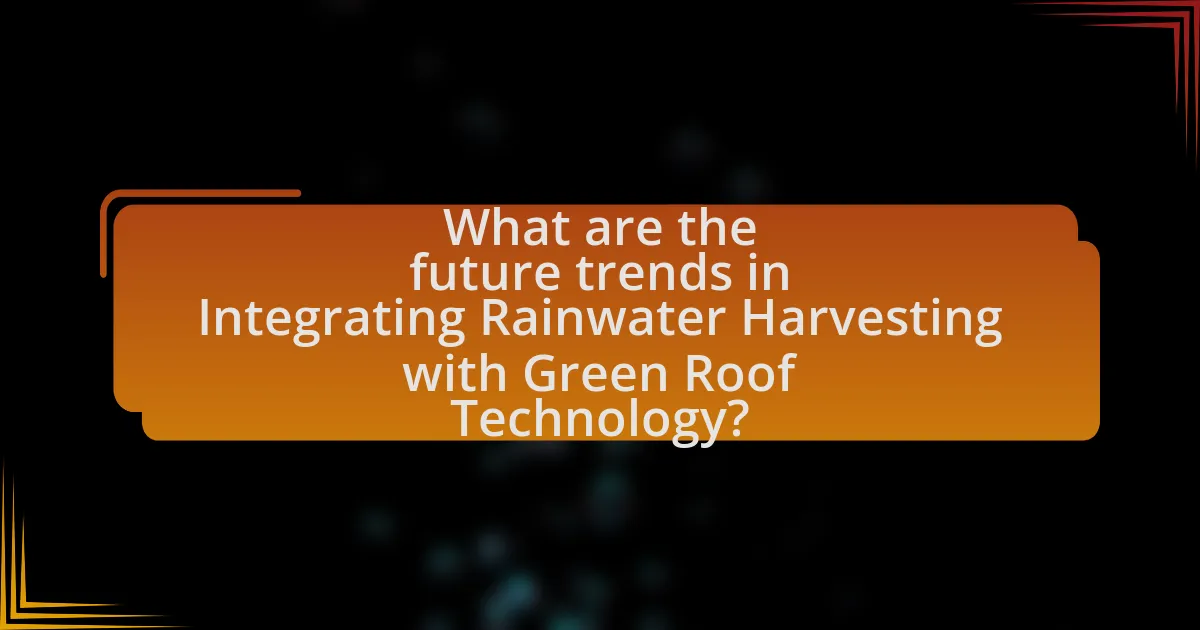
Future trends in integrating rainwater harvesting with green roof technology include the development of smart systems that utilize IoT sensors for real-time monitoring and management of water resources. These systems can optimize water usage by automatically adjusting irrigation based on weather forecasts and soil moisture levels. Additionally, there is a growing emphasis on using native plant species in green roofs to enhance biodiversity and improve the efficiency of rainwater absorption. Research indicates that combining these technologies can significantly reduce urban runoff and improve stormwater management, as evidenced by studies showing up to a 50% reduction in runoff in cities that have implemented such integrated systems.
How is technology advancing the integration of these systems?
Technology is advancing the integration of rainwater harvesting with green roof technology through the development of smart sensors and automated systems. These innovations enable real-time monitoring of rainfall, soil moisture, and water levels, allowing for efficient water management and optimized irrigation practices. For instance, systems equipped with IoT (Internet of Things) devices can automatically adjust water collection and distribution based on environmental conditions, enhancing the effectiveness of both rainwater harvesting and green roofs. Additionally, data analytics tools are being utilized to analyze performance metrics, leading to improved design and functionality of integrated systems.
What innovations are emerging in rainwater harvesting technology?
Innovations in rainwater harvesting technology include the integration of smart sensors and IoT devices that optimize water collection and usage. These advancements allow for real-time monitoring of rainfall, water levels, and system performance, enhancing efficiency and reducing waste. For instance, systems equipped with automated controls can adjust the collection process based on weather forecasts, ensuring maximum capture during heavy rains. Additionally, the development of modular and scalable storage solutions, such as underground tanks and permeable pavers, facilitates better integration with urban landscapes and green roofs, promoting sustainable water management practices.
How are green roof technologies evolving to support integration?
Green roof technologies are evolving to support integration by incorporating advanced systems for rainwater harvesting, enhancing both sustainability and efficiency. These technologies now feature integrated drainage systems that capture and store rainwater, which can be reused for irrigation or other non-potable applications. Recent studies indicate that green roofs equipped with rainwater harvesting systems can reduce stormwater runoff by up to 80%, significantly mitigating urban flooding and improving water management. Additionally, the use of smart sensors and automated controls in these systems allows for real-time monitoring and optimization of water usage, further promoting resource efficiency.
What are the potential impacts of climate change on this integration?
Climate change can significantly impact the integration of rainwater harvesting with green roof technology by altering precipitation patterns and increasing the frequency of extreme weather events. These changes can lead to either excessive rainfall, which may overwhelm rainwater harvesting systems, or prolonged droughts, reducing the availability of water for irrigation in green roofs. For instance, a study by the Intergovernmental Panel on Climate Change indicates that climate change is expected to increase the intensity and variability of rainfall, which can challenge the efficiency of rainwater collection and storage systems. Additionally, higher temperatures can increase evaporation rates, further stressing the water supply for green roofs.
How might changing weather patterns affect rainwater harvesting efficiency?
Changing weather patterns can significantly reduce rainwater harvesting efficiency by altering precipitation frequency and intensity. For instance, increased variability in rainfall can lead to longer dry spells, which diminishes the amount of water collected during sporadic heavy downpours. Research indicates that regions experiencing more extreme weather events, such as intense storms followed by droughts, may see a decrease in overall water availability for harvesting systems. Additionally, shifts in seasonal rainfall can disrupt the timing of water collection, making it less predictable and efficient.
What adaptations might green roofs need to remain effective?
Green roofs may need adaptations such as improved drainage systems, drought-resistant plant species, and enhanced soil composition to remain effective. Improved drainage systems can prevent waterlogging, which is crucial for plant health and longevity. Drought-resistant plant species ensure that the green roof can thrive during dry periods, reducing maintenance needs. Enhanced soil composition, including organic matter and moisture-retaining materials, supports plant growth and optimizes water retention, which is essential for integrating rainwater harvesting effectively. These adaptations are supported by studies indicating that proper drainage and plant selection significantly increase the resilience and functionality of green roofs in varying climatic conditions.
What best practices should be followed for successful integration?
Successful integration of rainwater harvesting with green roof technology requires careful planning, design, and maintenance. First, ensure that the green roof is designed to accommodate the rainwater harvesting system, including appropriate drainage and storage solutions. This involves selecting suitable plants that can thrive in the specific moisture conditions created by the harvested rainwater.
Next, implement a filtration system to maintain water quality, as contaminants can affect both the harvested water and the health of the green roof ecosystem. Regular maintenance is essential to prevent clogging and ensure the system operates efficiently.
Additionally, monitor the performance of both systems to optimize water usage and plant health, using data to make informed adjustments. Research indicates that integrated systems can reduce stormwater runoff by up to 65%, demonstrating the effectiveness of this approach in urban environments.
What maintenance tips can ensure long-term effectiveness of the systems?
Regular maintenance of rainwater harvesting systems and green roofs is essential for their long-term effectiveness. Key maintenance tips include inspecting and cleaning gutters and downspouts to prevent blockages, ensuring that the filtration systems are functioning properly to maintain water quality, and regularly checking the integrity of the green roof’s waterproof membrane to prevent leaks. Additionally, routine monitoring of plant health and soil moisture levels is crucial to support vegetation growth and prevent erosion. Research indicates that systems with consistent maintenance can achieve a lifespan of over 20 years, significantly enhancing their sustainability and efficiency.
How can stakeholders collaborate to enhance integration outcomes?
Stakeholders can collaborate to enhance integration outcomes by establishing clear communication channels and shared goals. Effective collaboration involves regular meetings and workshops where stakeholders, including urban planners, architects, and environmental engineers, can discuss project objectives and align their strategies. For instance, studies have shown that integrated project delivery methods, which involve all stakeholders from the project’s inception, lead to improved outcomes in sustainable design projects. This collaborative approach not only fosters innovation but also ensures that diverse perspectives are considered, ultimately resulting in more effective integration of rainwater harvesting with green roof technology.
